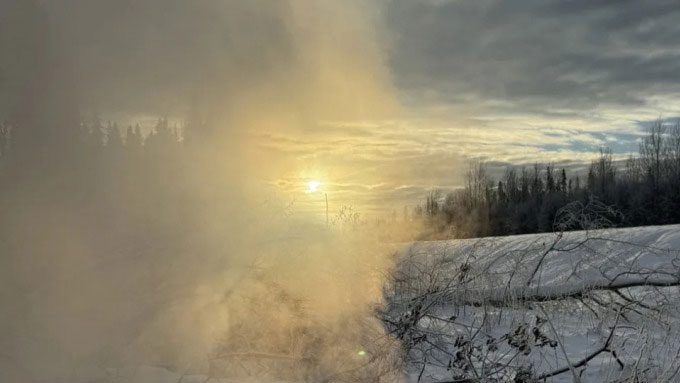Many of the fires from last year’s record wildfire season in Canada have not been fully extinguished, turning into smoldering “zombie fires” during the cold season.
During the frigid winter in Canada, the embers of last year’s record wildfire season are still present. These “zombie fires” continue to burn beneath the thick snow cover on an unprecedented scale, raising concerns about what could happen in the summer, BBC reported on February 16.

Smoke rising from a zombie fire in Fort Nelson, British Columbia. (Photo: BBC).
A zombie fire is a smoldering fire without flames, burning slowly underground, sustained by peat moss, an organic soil common in northern forests of North America, and insulated from the cold by thick layers of snow. This phenomenon is not uncommon; over the past decade, British Columbia has averaged 5 or 6 zombie fires existing during the cold months.
However, in January, British Columbia had as many as 106 active zombie fires, the highest level on record. According to provincial data, most of these typically extinguish by spring, but currently, 91 fires are still active. Fires that are not extinguished by March could flare up when the snow melts and they come into contact with the air. This has scientists concerned that the upcoming wildfire season may start earlier and be more intense.
The neighboring province of Alberta has also seen a spike in zombie fires, with 57 fires reported by early February, nearly ten times the average of the past five years.
This situation is alarming, especially following Canada’s record wildfire season last year, according to Jennifer Baltzer, a biology professor at Wilfrid Laurier University. More than 18 million hectares of land were burned in Canada in 2023, nearly equivalent to the size of Cambodia and far exceeding the North American country’s ten-year average. This was one of the deadliest seasons in recent years, with some firefighters losing their lives while on duty and thousands forced to evacuate their homes. The consequences even spread beyond Canada when smoke enveloped a vast area in the United States in June last year.
This devastating wildfire season is one of the reasons why British Columbia has such a high number of zombie fires, according to Mike Flannigan, a professor and wildfire management expert at Thompson Rivers University. He noted that most of these fires could not be fully extinguished last fall due to a lack of resources. Another reason is the severe drought that British Columbia has been experiencing for the past two years.
Previously, zombie fires were not a frequent occurrence. However, scientists indicate that they have become more common recently due to rapid climate warming. Currently, they are being monitored by authorities, according to Forrest Tower, an expert at British Columbia’s fire agency. He stated that the zombie fires are not currently posing a danger. But the major concern is that they could reignite if British Columbia continues to experience low snowfall and rainfall during the spring.


















































